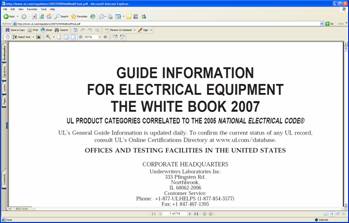UL White Book
 For the most part, the National Electrical Code contains requirements that are pretty straight forward, and only require a quick reading to fully understand. For example, all 125V, 15A and 20A receptacles in a bathroom must be GFCI-protected [210.8(A)(1) and 210.8(B)(1)]. Other requirements take a little more thought to fully understand, such as 250.4, which tells us that following all of Article 250 is simply a means of complying with section 250.4. Of all these rules in the NEC, however, there seems to be one rule that has a broader scope than any other rule, and that is 110.3(B). 110.3(B) tells us that if you install listed equipment, that equipment must be installed in accordance with the listing instructions.
For the most part, the National Electrical Code contains requirements that are pretty straight forward, and only require a quick reading to fully understand. For example, all 125V, 15A and 20A receptacles in a bathroom must be GFCI-protected [210.8(A)(1) and 210.8(B)(1)]. Other requirements take a little more thought to fully understand, such as 250.4, which tells us that following all of Article 250 is simply a means of complying with section 250.4. Of all these rules in the NEC, however, there seems to be one rule that has a broader scope than any other rule, and that is 110.3(B). 110.3(B) tells us that if you install listed equipment, that equipment must be installed in accordance with the listing instructions.
For the first few years of my electrical career, I didn’t know how to verify that I was following the listing instructions. I decided I would get the product standards for the equipment that I was installing, but then I found out that the standards aren’t free…in fact, they are far from it! It was a few years later that I was introduced to the UL Guide Information for Electrical Equipment (White Book). The White Book blew me away the first time I used it, because I found it to be so full of scattered information that I couldn’t find anything. There was nothing but a bunch of “product categories”, and even the people at UL didn’t know what they really meant, or what the rhyme and reason behind them was. A few years ago, however, UL revised the White Book to include a cross reference to related NEC sections.
Now when I see a metal outlet box in a fire-resistance rated wall, I can find the requirements for the box. 300.21 of the NEC tells us that the integrity of the wall shouldn’t be compromised, so I can look up section 300.21 in the White Book cross reference, and it tells me to go to Product Category “QCIT”. When I look in QCIT (metal outlet boxes), I find a few interesting things. For example:
- Metal boxes in a rated wall must be secured to the framing member, which means cut-in (or old work) boxes aren’t allowed.
- The answer to the age old question of “how many extension rings can be installed on a 4 in. box” is, quite simply, however many you want.
- Concentric knockouts in a 4 in. box don’t require bonding.
- Boxes for supporting a luminaire that weighs 50 or less pounds are marked “FOR FIXTURE SUPPORT” on the carton.
Some other things that I found in the White Book:
- Nearly all conduit fittings are listed for grounding and bonding (DWTT)
- Listed reducing washers are listed for grounding and bonding (QCRV)
- Reducing washers can be used on concentric knockouts…but only if all of the knockouts have been removed (QCRV).
- The “back-stab” terminals of switches (WJQR) and receptacles (RTRT) are okay for stranded or solid conductors, but they are not listed for aluminum conductors.
- Wire connectors for dissimilar materials can only be used in dry locations (AALZ).
- Galvanized rigid steel conduit installed in concrete does not require supplementary corrosion protection. (DYIX).
The White Book has a truly massive amount of information, and the information covers every end of the spectrum. Some of the requirements are obvious, some are obscure; some are useless, but most are highly useful. Most of these requirements can only be found in the White Book, not in the NEC.
Click here to download the UL White Book. The file is 15MB so it may take several minutes to download.
Ryan Jackson
Code Consultant, Mike Holt Enterprises